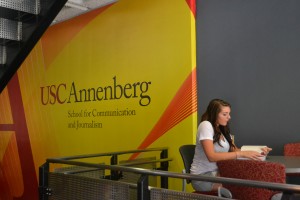Journalism master’s program shortened
To better serve its mission of preparing students to work in the best newsrooms around the world, the USC Annenberg School for Communication and Journalism is shortening its master’s degree program in journalism from two years to nine months.

Learning styles · Sophomore public relations major Jessica Dillion prepares for class at the Annenberg School of Communication and Journalism. – Jasmine Rolle | Daily Trojan
The change comes in response to shifting demands from employers in the news industry.
“One of the things that we do from time to time is we go out and look at what’s happening in the industry — where do our students go, what do they need, what do the news organizations say they want in a young journalist,” Michael Parks, interim director of the School of Journalism said. “We did that a couple of years ago, and we got back a set of things that said to us that we needed to change the program.”
This information, along with the construction of the new Wallis Annenberg Hall and input from students that a one-year program would be better suited to their needs, led to the idea of a shorter, more intensive program. The new program will be centered on workshops and skill-based learning as opposed to the traditional classroom environment. Plans for the program are underway, and Parks expects them to be completed by the start of the spring semester.
The program begins in the summer with a three-week long “boot camp” that covers basic skills in print, digital and broadcast journalism. The fall semester consists mainly of assignments in the media center, which include writing for Neon Tommy and other media outlets, to emphasize developing skills quickly. In the spring, the program shifts to more advanced applications of these skills.
The new program will also include the study of the media industry and journalism as a practice. Some new classes to be offered are a course on the business of journalism and “Numbers in the News,” a course on the use of data in storytelling.
Parks said that no new hires have been made so far, but there will be some changes in teaching assignments and possibly some new adjunct faculty brought on to facilitate the change.
“We have great resources here in Los Angeles and a great deal of excitement about this program,” Parks said.
One of the main focuses of the new program is to make students comfortable working across different media platforms in a converged newsroom.
“Working in a converged newsroom forces you to think not, ‘How can I do this story for TV, or for radio or print?’ but, ‘How can we do the best job we can on this story?’ [and] ‘How can we tell it in the most compelling way?” Gabriel Kahn, professor of professional practice at Annenberg, said.
The construction of the new Wallis Annenberg Hall is central to the success of the program. The new building will allow the different campus media outlets, from Neon Tommy to Annenberg Radio News, to work together in the “converged newsroom” that employers say they want students to be comfortable in.
The idea of the converged newsroom has become crucial because of the changing dynamics in the news industry, which are mostly because of increased use of technology by journalists.
“The industry itself is in a moment of tremendous transformation, which in the short term is great for the consumer but is brutal for the industry as they struggle for new ways to create value,” Kahn said. “If the industry is changing so quickly, then our programs should change even more quickly.”
In particular, the ubiquity of consumer technology has led to a breakdown of the traditional structure of most news organizations.
“Traditionally, if I’m sitting in my living room, I’m watching television journalism. If I’m in my car, I’m listening to radio journalism and in the morning when I sit down with a newspaper, that’s print journalism,” Kahn said. “That division is increasingly irrelevant, because if I’m using my iPad, I can consume all those forms of journalism on one device.”
The goal of the program is to make sure that students maintain the values and ethics of journalism while still being literate in the new technological tools available.
“The focus of the program is not teaching people how to use gadgets, but how to tell compelling stories using whatever gadgets might be relevant in the moment,” Kahn said.
Follow Anshu Siripurapu on Twitter @AnshuSiripurapu
